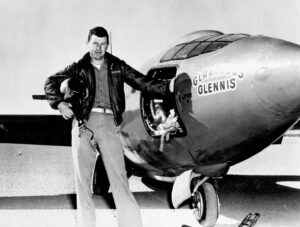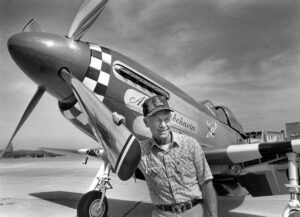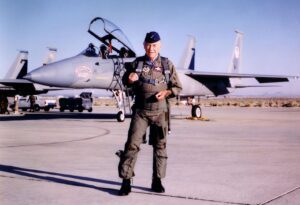Chuck Yeager and his journey from a young aircraft mechanic to a celebrated ace pilot is a testament to his unwavering determination, exceptional skill, and bravery. Enlisting in the U.S. Army Air Forces (USAAF) in 1941, Yeager’s remarkable career unfolded against the backdrop of World War II, where he would leave an indelible mark on the history of aviation. At the onset of his military service, Yeager’s age and educational background initially barred him from flight training. However, the entry of the U.S. into World War II prompted the USAAF to revise its recruiting standards, opening the door for Yeager to pursue his dreams of flight. Despite starting as an aircraft mechanic at George Air Force Base, Yeager’s sharp vision and determination caught the attention of his superiors. He was eventually accepted into flight training and graduated from Class 43C at Luke Field, Arizona, in March 1943. Assigned to the 357th Fighter Group, Yeager trained as a fighter pilot and flew Bell P-39 Airacobras before shipping overseas to the United Kingdom.
Chuck Yeager in Combat
In combat with the 363d Fighter Squadron, Yeager piloted P-51 Mustangs, naming his aircraft “Glamorous Glen” after his girlfriend, Glennis Faye Dickhouse, who would later become his wife. Despite facing the perils of aerial combat, Yeager’s exceptional flying skills and leadership soon became evident. On March 5, 1944, during his eight mission, Yeager’s aircraft was shot down over France. Displaying remarkable courage and resourcefulness, he escaped to Spain with the help of the French Resistance and returned to England two months later. Yeager’s bravery earned him the Bronze Star for assisting a fellow navigator during his escape. Despite regulations prohibiting “evaders” from flying over enemy territory again, Yeager successfully petitioned General Dwight D. Eisenhower to reinstate him to combat duty. His outstanding flying skills were soon evident as he achieved remarkable feats in aerial combat.
“Ace in a Day” for Chuck Yeager
On October 12, 1944, Yeager became the first pilot in his group to achieve “ace in a day,” downing five enemy aircraft in a single mission. His tally of 11.5 official victories included one of the first air-to-air victories over a jet fighter, a German Messerschmitt Me 262. Yeager’s wartime experiences were marked by both triumphs and moral dilemmas. He expressed disgust at the atrocities committed during the war and reflected on his own actions with regret. Despite the challenges and hardships he faced, Yeager’s integrity and dedication remained unwavering.
The Transition to Test Pilot
Upon returning to the United States in early 1945, Yeager continued his service as a test pilot at Wright Field. His extensive flight hours and maintenance experience made him a valuable asset in evaluating repaired aircraft, further solidifying his reputation as a skilled aviator. Chuck Yeager’s legacy as an aviation pioneer extends far beyond his historic flight breaking the sound barrier. His relentless pursuit of excellence and daring feats in the skies cemented his status as an icon of aviation history. Let’s delve into some of the incredible moments that defined Yeager’s post-war career as a test pilot.
Chuck Yeager after the War
After World War II, Yeager remained with the U.S. Army Air Forces, transitioning into the newly formed United States Air Force (USAF). He took on the role of a test pilot at Muroc Army Air Field, now known as Edwards Air Force Base. It was during this time that Yeager became involved in a groundbreaking endeavor that would propel him into the annals of aviation history. When Bell Aircraft’s test pilot demanded an exorbitant sum to break the sound barrier, the USAAF turned to the 24-year-old Yeager. Selected to pilot the rocket-powered Bell XS-1 as part of a NACA (National Advisory Committee for Aeronautics) program, Yeager faced daunting challenges that few had dared to confront. Just days before the scheduled flight, Yeager suffered two broken ribs in a fall from a horse. Determined not to let this setback derail his mission, he pressed on with the support of his friend and fellow pilot, Jack Ridley. With Ridley’s ingenuity and a makeshift lever, Yeager managed to seal the X-1’s hatch despite the excruciating pain.
Breaking the Sound Barrier
On October 14, 1947, Chuck Yeager shattered the sound barrier, flying the X-1 Glamorous Glennis at Mach 1.05 over the Mojave Desert in California. The success of this mission, kept secret for nearly eight months, marked a monumental achievement in aviation history. For his pioneering flight, Yeager received prestigious awards, including the Mackay Trophy and the Collier Trophy. The X-1 aircraft he piloted that day found its place of honor at the Smithsonian Institution’s National Air and Space Museum.
Undeterred by his groundbreaking achievement, Yeager continued to push the boundaries of flight. He broke numerous speed and altitude records, demonstrating his exceptional flying skills and courage. In 1953, Yeager faced a new challenge as part of the USAF team working on the X-1A, designed to surpass Mach 2 in level flight. Despite encountering unexpected obstacles, including a harrowing incident of losing control of the X-1A at high altitude, Yeager’s skill and composure prevailed. His daring exploits earned him the Distinguished Service Medal in 1954, solidifying his reputation as one of the greatest test pilots of all time.
Wrapping it Up
Chuck Yeager’s fearless determination and unwavering commitment to pushing the limits of flight continue to inspire generations of aviators and astronauts. His legacy serves as a reminder of the boundless possibilities that await those who dare to defy gravity and reach for the skies. Well that’s it for this week, until next time remember to Be Social, Fly Private!



